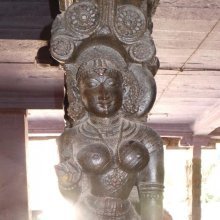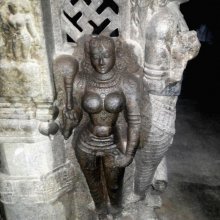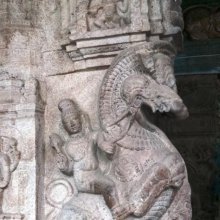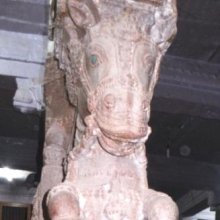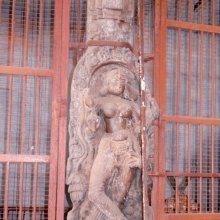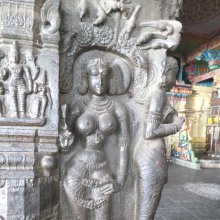Camara, Cāmara, Camará: 38 definitions
Introduction:
Camara means something in Buddhism, Pali, Hinduism, Sanskrit, Jainism, Prakrit, the history of ancient India, Marathi, Hindi, biology. If you want to know the exact meaning, history, etymology or English translation of this term then check out the descriptions on this page. Add your comment or reference to a book if you want to contribute to this summary article.
Alternative spellings of this word include Chamara.
Images (photo gallery)
(+10 more images available)
In Hinduism
Ayurveda (science of life)
Source: Wisdom Library: Āyurveda and botanyCamara (चमर) is a Sanskrit word referring to the animal “yak”. The meat of this animal is part of the māṃsavarga (‘group of flesh’), which is used throughout Ayurvedic literature. The animal Camara is part of the sub-group named Ānupamṛga, refering to animals “who live in marshy land”. It was classified by Caraka in his Carakasaṃhitā sūtrasthāna (chapter 27), a classical Ayurvedic work. Caraka defined such groups (vargas) based on the dietic properties of the substance.
Source: archive.org: Sushruta samhita, Volume ICamara (चमर) or Chamara (छमर)—Sanskrit word for the animal “yak”. This animal is from the group called Kūlacara (‘shore-dwellers’). Kūlacara itself is a sub-group of the group of animals known as Ānupa (those that frequent marshy places).
The flesh of the Chamara is demulcent, cures an attack of cough, is sweet in taste and digestion and subdues the deranged Vāyu and Pittam.

Āyurveda (आयुर्वेद, ayurveda) is a branch of Indian science dealing with medicine, herbalism, taxology, anatomy, surgery, alchemy and related topics. Traditional practice of Āyurveda in ancient India dates back to at least the first millenium BC. Literature is commonly written in Sanskrit using various poetic metres.
Shilpashastra (iconography)
Source: Red Zambala: Hindu Icons and Symbols | IntroductionCāmara (Fly-whisk) - The obedience to the law and in particular to the highest principle of Dharma — Ahimsa. Also represents the following of the teacher and the tradition.
Source: Shodhganga: Elements of Art and Architecture in the Trtiyakhanda of the Visnudharmottarapurana (shilpa)Cāmara (चामर) refers to the “bushy tail of yak” and is associated with Varuṇa, whose iconography is described in the Viṣṇudharmottarapurāṇa, an ancient Sanskrit text which (being encyclopedic in nature) deals with a variety of cultural topics such as arts, architecture, music, grammar and astronomy.—The images of Gaṅgā and Yamunā are also placed in the right and left side of the image of Varuṇa respectively. The image of Gaṅgā should be placed on a crocodile and should hold cāmara i.e., bushy tail of yak. The Viṣṇudharmottarapurāṇa states that the image of Yamunā should be placed on a tortoise and also have cāmara in her hand. Thus it is clear that the Viṣṇudharmottarapurāṇa offers a great field of knowledge regarding the nuances of Indian art of Image making [e.g., the cāmara] during 10th–11th century A.D.

Shilpashastra (शिल्पशास्त्र, śilpaśāstra) represents the ancient Indian science (shastra) of creative arts (shilpa) such as sculpture, iconography and painting. Closely related to Vastushastra (architecture), they often share the same literature.
Natyashastra (theatrics and dramaturgy)
Source: Wisdom Library: Nāṭya-śāstraCāmara (चामर) refers to a “chowrie” (a whisk to keep off flies), which is an accessories used in a dramatic play, according to Nāṭyaśāstra chapter 23. Such accessories and weapons should be made by experts using proper measurements and given to persons in their respective conditions. It forms a component of āhāryābhinaya (extraneous representation).

Natyashastra (नाट्यशास्त्र, nāṭyaśāstra) refers to both the ancient Indian tradition (shastra) of performing arts, (natya—theatrics, drama, dance, music), as well as the name of a Sanskrit work dealing with these subjects. It also teaches the rules for composing Dramatic plays (nataka), construction and performance of Theater, and Poetic works (kavya).
Chandas (prosody, study of Sanskrit metres)
Source: Shodhganga: a concise history of Sanskrit Chanda literatureCāmara (चामर) refers to one of the 130 varṇavṛttas (syllabo-quantitative verse) dealt with in the second chapter of the Vṛttamuktāvalī, ascribed to Durgādatta (19th century), author of eight Sanskrit work and patronised by Hindupati: an ancient king of the Bundela tribe (presently Bundelkhand of Uttar Pradesh). A Varṇavṛtta (e.g., cāmara) refers to a type of classical Sanskrit metre depending on syllable count where the light-heavy patterns are fixed.

Chandas (छन्दस्) refers to Sanskrit prosody and represents one of the six Vedangas (auxiliary disciplines belonging to the study of the Vedas). The science of prosody (chandas-shastra) focusses on the study of the poetic meters such as the commonly known twenty-six metres mentioned by Pingalas.
Purana and Itihasa (epic history)
Source: archive.org: Puranic Encyclopedia1) Camara (चमर).—(CAMARĪ). An animal whose tail is its most important and valued organ. In the course of its movements in the forest if the tail gets entangled anywhere it is supposed to lie down there till the tail is freed by itself. About the origin of Camara, the following story is told in the Vālmīki Rāmāyaṇa. Krodhavaśā, daughter of Dakṣaprajāpati and wife of Kaśyapa had ten daughters, viz. Mṛgī, Mṛgamadā, Hari, Bhadramadā, Mātaṅgī, Śārdūlī, Śvetī, Surasā, Surabhi and Kadrū. To Mṛgamadā the Sṛmaras and Camaras owe their origin. (Vālmīki Rāmāyaṇa, Araṇya Kāṇḍa, Canto 14).
2) Cāmara (चामर).—A rod (handle) with a large tuft of hair, fibre or feathers at the end. A symbol used by kings and brahmins. Cāmara of the king should have a golden handle, and it should be made of the wings of the swan, the pea cock, the Balākā bird etc. But, the wings of different birds shall not be intermixed. Circular in shape, the Cāmara should have on its handle 3, 4, 5, 6, 7, or 8 sandhis (joints, knots). (Agnipurāṇa, Chapter 245).
Source: archive.org: Shiva Purana - English TranslationCāmara (चामर) refers to “chowries” which forms part of the royal paraphernalia (mahārājopacāra), according to the Śivapurāṇa 2.2.28. Accordingly as Brahmā narrated to Nārada:—“[...] Lord Śiva, possessed of the perfect vision, realising everything and seeing all, and the cause of protection, being requested by the Goddess, spoke to her:—‘[...] You can go in royal splendour mounting this bull richly caparisoned’. Satī thus commanded to mount the decorated bull, bedecked herself and started for her father’s abode. The royal paraphernalia (mahārājopacāra) like the umbrella, chowries (cāmara), silken clothes and ornaments were given to her by (Śiva) the great lord”.

The Purana (पुराण, purāṇas) refers to Sanskrit literature preserving ancient India’s vast cultural history, including historical legends, religious ceremonies, various arts and sciences. The eighteen mahapuranas total over 400,000 shlokas (metrical couplets) and date to at least several centuries BCE.
Vaishnavism (Vaishava dharma)
Source: Pure Bhakti: Arcana-dipika - 3rd EditionCāmara (चामर) refers to a “whisk” and represents one of the articles offered during Maṅgalārati, according to the Arcana-dīpikā (manual on deity worship).—Before each article is offered, purify the right hand [with a drop of water from the pañca-pātra], and then purify the article [viz., cāmara]. Chant the mūla-mantra for the deity and then offer the article.
Source: Pure Bhakti: Brhad BhagavatamrtamCāmara (चामर) refers to:—Yaktail fan. (cf. Glossary page from Śrī Bṛhad-bhāgavatāmṛta).

Vaishnava (वैष्णव, vaiṣṇava) or vaishnavism (vaiṣṇavism) represents a tradition of Hinduism worshipping Vishnu as the supreme Lord. Similar to the Shaktism and Shaivism traditions, Vaishnavism also developed as an individual movement, famous for its exposition of the dashavatara (‘ten avatars of Vishnu’).
Dharmashastra (religious law)
Source: Prācyā: Animals and animal products as reflected in Smṛti textsCamara (चमर) refers to the animal “Yak” (Bos grunniens).—The Smṛtis mention several domestic as well as wild animals that are enumerated in context of specifying expiation for killing them, the flesh being used as a dietary article to give satisfaction to the Manes (Pitṛs) in Śrāddha rites, the law of transmigration due to various sins committed as well as in the context of specifying gifts to be given on various occasions. These animals [viz., Camara] are chiefly mentioned in the Manusmṛti, Parāśarasmṛti [Chap.6], Gautamasmṛti [17.2 and 15.1], Śātātapasmṛti [II.45-54], Uśānasmṛti [IX.7-9; IX.12-13], Yājñavalkyasmṛti [I.170-171; I.175; I.258- 260], Viṣṇusmṛti [51.3;51.6;51.26;51.33;80.3-14], Uttarāṅgirasasmṛti [X.15-17], Prajāpatismṛti [Śrāddhatyājyavastuvarṇanam. 138-143], 9 Kāśyapasmṛti [Section on Prāyaścittavarṇanam], Vṛddha Hārītasmṛti [6.253-255] and Kātyāyanasmṛti [27.11].

Dharmashastra (धर्मशास्त्र, dharmaśāstra) contains the instructions (shastra) regarding religious conduct of livelihood (dharma), ceremonies, jurisprudence (study of law) and more. It is categorized as smriti, an important and authoritative selection of books dealing with the Hindu lifestyle.
Kavya (poetry)
Source: Wisdom Library: KathāsaritsāgaraCāmara (चामर) refers to “chowries fans”, according to the seventeenth story of the Vetālapañcaviṃśati in the Kathāsaritsāgara, chapter 91. Accordingly, as the Vetāla said to king Trivikramasena:—“... servants are bound to preserve their masters even by the sacrifice of their lives. But kings are inflated with arrogance, uncontrollable as elephants, and when bent on enjoyment they snap as under the chain of the moral law. [...] And the breeze of the waving chowries fans [viz., cāmara-māruta] away the atoms of the sense of scripture taught them by old men, as it fans away flies and mosquitoes. [...]”.
The Kathāsaritsāgara (‘ocean of streams of story’), mentioning cāmara-māruta, is a famous Sanskrit epic story revolving around prince Naravāhanadatta and his quest to become the emperor of the vidyādharas (celestial beings). The work is said to have been an adaptation of Guṇāḍhya’s Bṛhatkathā consisting of 100,000 verses, which in turn is part of a larger work containing 700,000 verses.
Source: Brill: Śaivism and the Tantric Traditions (kavya)Cāmara (चामर) refers to a “yak-tail whisk”, according to Bāṇa’s Kādambarī (p. 224).—Accordingly, “[From afar] Candrāpīḍa first sees a ‘crimson ensign’, inscribing the sky with a gold trident, from which swung a terrifying bell making a raucous clanging that dangled down from an iron chain attached to the tip, arranged with a yak-tail whisk (cāmara) as splendid as a lion’s mane”.

Kavya (काव्य, kavya) refers to Sanskrit poetry, a popular ancient Indian tradition of literature. There have been many Sanskrit poets over the ages, hailing from ancient India and beyond. This topic includes mahakavya, or ‘epic poetry’ and natya, or ‘dramatic poetry’.
Jyotisha (astronomy and astrology)
Source: Wisdom Library: Brihat Samhita by VarahamihiraCāmara (चामर) refers to “hairy fans”, according to the Bṛhatsaṃhitā (chapter 2), an encyclopedic Sanskrit work written by Varāhamihira mainly focusing on the science of ancient Indian astronomy astronomy (Jyotiṣa).—Accordingly, “A true Astrologer is also one who has thoroughly mastered the Science of Saṃhitā. [...] It also treats of the prediction of events from the flight of the kañjana and from the appearance of various abnormal phenomena, of expiatory ceremonies; of miscellaneous planetary phenomena; of ghṛta-kambala; of the royal sword; of paṭa; of the features of a house cock, a cow, a sheep, a horse, an elephant, a man and a woman. It also treats of the treatment of women; of moles in the body; of injuries to shoes and clothes; of hairy fans [i.e., cāmara]; of walking sticks: of beds and seats; of lamplight; of tooth brush and the like”.

Jyotisha (ज्योतिष, jyotiṣa or jyotish) refers to ‘astronomy’ or “Vedic astrology” and represents the fifth of the six Vedangas (additional sciences to be studied along with the Vedas). Jyotisha concerns itself with the study and prediction of the movements of celestial bodies, in order to calculate the auspicious time for rituals and ceremonies.
In Buddhism
Tibetan Buddhism (Vajrayana or tantric Buddhism)
Source: academia.edu: The Structure and Meanings of the Heruka MaṇḍalaCamara (चमर) is the name of a Vīra (hero) who, together with the Ḍākinī named Camarī forms one of the 36 pairs situated in the Medinīcakra, according to the 10th century Ḍākārṇava chapter 15. Accordingly, the medinīcakra refers to one of the three divisions of the dharma-puṭa (‘dharma layer’), situated in the Herukamaṇḍala. The 36 pairs of Ḍākinīs and Vīras [viz., Camara] are yellow in color; the shapes of their faces are in accordance with their names; they have four arms; they hold a skull bowl, a skull staff, a small drum, and a knife.

Tibetan Buddhism includes schools such as Nyingma, Kadampa, Kagyu and Gelug. Their primary canon of literature is divided in two broad categories: The Kangyur, which consists of Buddha’s words, and the Tengyur, which includes commentaries from various sources. Esotericism and tantra techniques (vajrayāna) are collected indepently.
In Jainism
General definition (in Jainism)
Source: archive.org: Trisastisalakapurusacaritra1) Camara (चमर) is the name of an Asura from Cāmaracañcā, as mentioned to chapter 1.2 [ādīśvara-caritra] of Hemacandra’s 11th century Triṣaṣṭiśalākāpuruṣacaritra: an ancient Sanskrit epic poem narrating the history and legends of sixty-three illustrious persons in Jainism.—Accordingly, “[...] In the city Cāmaracañcā in the assembly-hall Sudharmā, the Asura Camara, seated on the lion throne Camara, knew the Jina’s birth by clairvoyant knowledge and had the bell oghasvarā rung by Druma, the chief of his infantry, to inform the people. Attended by sixty-four thousand Sāmānikas, thirty-three Trāyastriṃśas, four Lokapālas, five chief-queens, three councils, seven great armies and their seven commanders, sixty-four thousand body-guards in each direction, and by other powerful princes also, the Asura [Camara] got into a car fifty thousand yojanas square, adorned with a great banner five hundred yojanas high, which had been made at once by an Abhiyogya-god, and set out with the desire to perform the birth-festival of the Master”.
2) Camara (चमर) is the name of a Vidyādhara-city, situated on mount Vaitāḍhya (in the northern row), according to chapter 1.3.—Accordingly, “[...] Taking their families and all their retinue and ascending the best of cars, they went to Vaitāḍhya. [...] Ten yojanas above the earth, King Vinami made at once sixty cities in a northern row at the command of the Nāga-king. [viz., Cāmara]. Vinami himself, who had resorted to Dharaṇendra, inhabited the city Gaganavallabha, the capital of these. [...] The two rows of Vidyādhara-cities looked very magnificent, as if the Vyantara rows above were reflected below. After making many villages [viz., Cāmara] and suburbs, they established communities according to the suitability of place. The communities there were called by the same name as the community from which the men had been brought and put there. [...]”.
3) Cāmara (चामर) refers to one of the seven sons of Dhāraṇī and king Śrīnandana from Prabhāpura, according to the Jain Ramayana and chapter 7.8 [The abandonment of Sītā].—Accordingly, “Now seven sons were born in succession to Dhāraṇī, wife of Śrīnandana, lord of Prabhāpura: [e.g., Cāmara, ...]. One day Śrīnandana established his son who was a month old on the throne and with his sons became a mendicant under the teacher Prītikara. [...]”.
Source: Encyclopedia of Jainism: Tattvartha Sutra 4: The celestial beings (deva)Camara (चमर) refers to one of the two Indras (lords) of the Asurakumāra (fiendish youths) class of “residential celestial beings” (bhavanavāsin), itself a main division of devas (celestial beings) according to the 2nd-century Tattvārthasūtra 4.3. The Asurakumāras go down to the third ‘earth’ of the lower world and encourage the infernal beings there to fight amongst themselves to cause misery to them. As they enjoy and indulge in violence, they are called fiendish youths. Camara and Vairocana are the two lords in the Fiendish-youths residential celestial beings.

Jainism is an Indian religion of Dharma whose doctrine revolves around harmlessness (ahimsa) towards every living being. The two major branches (Digambara and Svetambara) of Jainism stimulate self-control (or, shramana, ‘self-reliance’) and spiritual development through a path of peace for the soul to progess to the ultimate goal.
India history and geography
Source: Knowledge Traditions & Practices of India: Trade: A SurveyCamara (known as Puhar or Kāveripaṭṭinam in Tamil literature) is the name of a port city mentioned in the 1st century Periplus Maris Erythraei in connection with overseas trading in ancient India.—Ports thus dotted the Indian coast, and many of them were listed in Greek and Roman texts, such as the Periplus Maris Erythraei or “Voyage around the Erythrean Sea”, an anonymous Greek travelogue of the 1st century CE, ‘Erythrean’ referring to the Arabian Sea together with the Red Sea and the Persian Gulf. It named ports such as Camara, among many others.
Source: Cologne Digital Sanskrit Dictionaries: Indian Epigraphical GlossaryCāmara.—(IE 8-8), name of a coin; cf. cāmara-māda. (SII 3), a fly-whisk. See cauri, cavarālu. Note: cāmara is defined in the “Indian epigraphical glossary” as it can be found on ancient inscriptions commonly written in Sanskrit, Prakrit or Dravidian languages.
--- OR ---
Cāmara.—also called cāmara-māḍa; probably ‘a māḍa bearing the figure of a fly-whisk’; see māḍa. Note: cāmara is defined in the “Indian epigraphical glossary” as it can be found on ancient inscriptions commonly written in Sanskrit, Prakrit or Dravidian languages.
Source: Singhi Jain Series: Ratnaprabha-suri’s Kuvalayamala-katha (history)Camara (चमर) refers to one of the various shops or “market places” (Sanskrit: Haṭṭa, Prakrit: Cauhaṭṭa) for a medieval town in ancient India, which were vividly depicted in Kathās (narrative poems), for example, by Uddyotanasūri in his 8th-century Kuvalayamālā.—The Kuvalayamala (779 A.D.) is full of cultural material which gains in value because of the firm date of its composition. [...] In the Kuvalayamālā, some names of shops according to articles displayed in them is given, [i.e., camara] [...] Thus Uddyotana has in his view a complete form of a medieval market place with the number of lines full of different commodities.

The history of India traces the identification of countries, villages, towns and other regions of India, as well as mythology, zoology, royal dynasties, rulers, tribes, local festivities and traditions and regional languages. Ancient India enjoyed religious freedom and encourages the path of Dharma, a concept common to Buddhism, Hinduism, and Jainism.
Biology (plants and animals)
Source: Google Books: CRC World Dictionary (Regional names)Camara in South and Central America is the name of a plant defined with Lantana camara in various botanical sources. This page contains potential references in Ayurveda, modern medicine, and other folk traditions or local practices It has the synonym Lantana camara f. nana (Moldenke) Moldenke (among others).
Example references for further research on medicinal uses or toxicity (see latin names for full list):
· The Gardeners Dictionary (1768)
· Phytologia (1976)
· Boletim de Botânica da Universidade de São Paulo (2003)
· Phytologia (1980)
· South African Journal of Botany (1984)
· Repertorium Specierum Novarum Regni Vegetabilis (1906)
If you are looking for specific details regarding Camara, for example side effects, pregnancy safety, health benefits, chemical composition, diet and recipes, extract dosage, have a look at these references.

This sections includes definitions from the five kingdoms of living things: Animals, Plants, Fungi, Protists and Monera. It will include both the official binomial nomenclature (scientific names usually in Latin) as well as regional spellings and variants.
Languages of India and abroad
Pali-English dictionary
Source: BuddhaSasana: Concise Pali-English Dictionarycamara : (m.) the yak ox (in the Himalayan regions). || cāmara (nt.) a chowrie; the tail of the yak used as a whisk.
Source: Sutta: The Pali Text Society's Pali-English DictionaryCāmara, (nt.) (from camara) a chowrie, the tail of bos grunniens used as a whisk Sn. 688; Vv 643; J. VI, 510; VvA. 271, 276. Cpd. cāmarī-gāhaka J. VI, 218 (aṅka) a hook holding the whisk. (Page 264)
— or —
Camara, (Deriv. unknown, probably non-Aryan. Sk. camara) 1. the Yak ox (Bos grunniens) J. I, 149; III, 18, 375; V, 416; Miln. 365.—f. —ī J. I, 20; Sdhp. 621.—In cpds. camari° J. IV, 256.—2. a kind of antelope (-ī) J. VI, 537.

Pali is the language of the Tipiṭaka, which is the sacred canon of Theravāda Buddhism and contains much of the Buddha’s speech. Closeley related to Sanskrit, both languages are used interchangeably between religions.
Marathi-English dictionary
Source: DDSA: The Molesworth Marathi and English Dictionarycāmara (चामर).—n (S) A chowrie; the tail of Bos Grunniens, used to whisk off flies &c. v vāra, ḍhāḷa.
Source: DDSA: The Aryabhusan school dictionary, Marathi-Englishcāmara (चामर).—n A chowrie; see cavarī.
Marathi is an Indo-European language having over 70 million native speakers people in (predominantly) Maharashtra India. Marathi, like many other Indo-Aryan languages, evolved from early forms of Prakrit, which itself is a subset of Sanskrit, one of the most ancient languages of the world.
Sanskrit dictionary
Source: DDSA: The practical Sanskrit-English dictionaryCamara (चमर).—[cam-arac Uṇādi-sūtra 3.31] A kind of deer.
-raḥ, -ram A chowrie most usually made of the tail of Chamara.
-rī 1 A shoot, sprout (mañjarī).
2) The female Chamara; यस्यार्थयुक्तं गिरिराजशब्दं कुर्वन्ति बालव्यजने- श्चमर्यः (yasyārthayuktaṃ girirājaśabdaṃ kurvanti bālavyajane- ścamaryaḥ) Kumārasambhava 1.13,48; Śiśupālavadha 4.6; Meghadūta 53; केशेषु चमरीं हन्ति सीम्नि पुष्करको हतः (keśeṣu camarīṃ hanti sīmni puṣkarako hataḥ) Udb.; cf. चमरं चामरे स्त्री तु मञ्जरीमृग- भेदयोः (camaraṃ cāmare strī tu mañjarīmṛga- bhedayoḥ) Medinī.
Derivable forms: camaraḥ (चमरः).
--- OR ---
Cāmara (चामर).—[camaryāḥ vikāraḥ tatpucchanirmitatvāt] also
-rā -rī sometimes.
1) A chowrie or bushy tail of the Chamara (Bos Grunniens) used as a fly-flap or fan, and reckoned as one of the insignia of royalty (and sometimes used as a sort of streamer on the heads of horses); व्याधूयन्ते निचुलतरुभिर्मञ्जरीचामराणि (vyādhūyante niculatarubhirmañjarīcāmarāṇi) V.4.4; अदेय- मासीत् त्रयमेव भूपतेः शशिप्रभं छत्रमुभे च चामरे (adeya- māsīt trayameva bhūpateḥ śaśiprabhaṃ chatramubhe ca cāmare) R.3.16; Kumārasambhava 7.42; H.2.29; Meghadūta 35; चित्रन्यस्तमिवाचलं हयशिर- स्यायामवच्चामरम् (citranyastamivācalaṃ hayaśira- syāyāmavaccāmaram) V.1.4; Ś.1.8.
Derivable forms: cāmaraḥ (चामरः), cāmaram (चामरम्).
Source: Cologne Digital Sanskrit Dictionaries: Edgerton Buddhist Hybrid Sanskrit DictionaryCamara (चमर).—m., a high number: Mahāvyutpatti 7787 = Tibetan rgod-yas (meaning ?).
--- OR ---
Cāmara (चामर).—name of a country or division of the world: Mahāvyutpatti 3052. Cf. Aparacāmara. See Kirfel, Kosmographie, 90 (var. Ḍāmara).
--- OR ---
Cāmarā (चामरा).—(AMg. and Sanskrit Lex. id., f.; compare Pali and Sanskrit Lex. cāmarī; regularly nt. °ra in Sanskrit, Pali, and Prakrit), chowrie: vara-cāmarāye (instr.) Mahāvastu i.235.8 (verse).
Source: Cologne Digital Sanskrit Dictionaries: Shabda-Sagara Sanskrit-English DictionaryCamara (चमर).—n.
(-raṃ) 1. A Chowri or long brush, most usually made of the tail-hairs of the Yak or Bos Grunniens, and employed to whisk off insects, flies, &c. 2. The name of a demon, f. (-rī) A compound pedicle. mf. (-raḥ-rī) A kind of deer, or rather the Bos Grunniens, erroneously classed by the Hidu writers amongst the deer. E. cam to eat or be eaten, arac aff.
--- OR ---
Cāmara (चामर).—nf. (-raṃ-rā or -rī) A Chowri, the bushy tail of the Bos grun niens, used to whisk off flies, also as an emblem or insignia of princely rank. E. camara the Yak or Bos grunniens, and aṇ aff.
Source: Cologne Digital Sanskrit Dictionaries: Benfey Sanskrit-English DictionaryCamara (चमर).—I. m. Bos grunniens, [Rāmāyaṇa] 3, 49, 24. Ii. m. and n. The tail of the Bos grunniens, used to whisk off insects, flies, etc.; one of the insignia of royalty, Mahābhārata 2, 1861; [Vikramorvaśī, (ed. Bollensen.)] [distich] 76.
--- OR ---
Cāmara (चामर).—i. e. camara + a, n. The tail of the Bos grunniens, used to whisk off flies, and one of the insignia of royalty, [Rājataraṅgiṇī] 5, 449: [Meghadūta, (ed. Gildemeister.)] 36. Used also as an ornament on the heads of horses, [Śākuntala, (ed. Böhtlingk.)] [distich] 8.
Source: Cologne Digital Sanskrit Dictionaries: Cappeller Sanskrit-English DictionaryCamara (चमर).—[masculine] i [feminine] the Yak (Bos Grunniens); [masculine] [neuter] the chowrie, a long brush made of the tail of the Yak.
--- OR ---
Cāmara (चामर).—[adjective] coming from the Yak; [neuter] chowrie ( = camara).
Source: Cologne Digital Sanskrit Dictionaries: Monier-Williams Sanskrit-English Dictionary1) Camara (चमर):—m. a kind of ox called the Yak (Bos grunniens), [Mahābhārata; Rāmāyaṇa] etc.
2) mn. the bushy tail of the Yak (employed as chowrie or long brush for whisking off insects, flies, etc. ; one of the insignia of royalty; cf. cām), [Mahābhārata ii, xii; Bhartṛhari; Kathāsaritsāgara lix, 42]
3) a particular high number, [Buddhist literature]
4) m. Name of a Daitya, [cf. Lexicographers, esp. such as amarasiṃha, halāyudha, hemacandra, etc.]
5) Cāmara (चामर):—mfn. coming from the Yak (cam), [Bhāgavata-purāṇa viii, 10, 13]
6) belonging to a chowrie, [cf. Lexicographers, esp. such as amarasiṃha, halāyudha, hemacandra, etc.]
7) m. = cam (q.v.), a chowrie, [Bhoja]
8) n. idem (a kind of plume on the heads of horses etc., [Śakuntalā; Vikramorvaśī; Kādambarī]), [Mahābhārata] etc. (ifc. f(ā). , [Kumāra-sambhava vii, 42])
9) n. a metre of 4 x 15 syllables
10) = daṇḍa (a stick), [cf. Lexicographers, esp. such as amarasiṃha, halāyudha, hemacandra, etc.]
11) Cāmarā (चामरा):—[from cāmara] f. idem, [cf. Lexicographers, esp. such as amarasiṃha, halāyudha, hemacandra, etc.]
12) [v.s. ...] (ā, ī) f. a chowrie, [cf. Lexicographers, esp. such as amarasiṃha, halāyudha, hemacandra, etc. [Scholiast or Commentator]]
Source: Cologne Digital Sanskrit Dictionaries: Yates Sanskrit-English Dictionary1) Camara (चमर):—(raṃ) 1. n. The chauri used to wisk off flies, &c. m. f. Bos grunniens. f. Compound pedicle.
2) Cāmara (चामर):—[(raṃ-rā)] 1. n. f. A chaurī.
Source: DDSA: Paia-sadda-mahannavo; a comprehensive Prakrit Hindi dictionary (S)Camara (चमर) in the Sanskrit language is related to the Prakrit words: Camara, Cāmara.
[Sanskrit to German]
Sanskrit, also spelled संस्कृतम् (saṃskṛtam), is an ancient language of India commonly seen as the grandmother of the Indo-European language family (even English!). Closely allied with Prakrit and Pali, Sanskrit is more exhaustive in both grammar and terms and has the most extensive collection of literature in the world, greatly surpassing its sister-languages Greek and Latin.
Hindi dictionary
Source: DDSA: A practical Hindi-English dictionaryCamāra (चमार) [Also spelled chamar]:—(nm) a cobbler, shoe-maker; a scheduled caste amongst the Hindus traditionally living by shoe-making; a lowly person; ~[rina/rī] feminine form of [camāra].
...
Prakrit-English dictionary
Source: DDSA: Paia-sadda-mahannavo; a comprehensive Prakrit Hindi dictionary1) Camara (चमर) in the Prakrit language is related to the Sanskrit word: Camara.
2) Camara (चमर) also relates to the Sanskrit word: Cāmara.
3) Cāmara (चामर) also relates to the Sanskrit word: Cāmara.
Prakrit is an ancient language closely associated with both Pali and Sanskrit. Jain literature is often composed in this language or sub-dialects, such as the Agamas and their commentaries which are written in Ardhamagadhi and Maharashtri Prakrit. The earliest extant texts can be dated to as early as the 4th century BCE although core portions might be older.
Kannada-English dictionary
Source: Alar: Kannada-English corpusCamara (ಚಮರ):—
1) [noun] a stocky, long-haired wild ox (Bos grunniens); yak.
2) [noun] the long hair of yak (Bos gruniens).
3) [noun] a fan made of its hair.
--- OR ---
Cāmara (ಚಾಮರ):—
1) [noun] a fan made of the long hair of yak (Bos grunniens).
2) [noun] (fig.) a sweeping broom.
3) [noun] ಚಾಮರವನಿಡು [camaravanidu] cāmaravaniḍu = ಚಾಮರವಿಕ್ಕು [camaravikku]; ಚಾಮರಸೇವೆ [camaraseve] cāmara sēve (in temples) a moving or agitating the air with a fan, a service to the God; 2. (fig.) to beat with a broom; ಚಾಮರಹಾಕು [camarahaku] cāmara hāku = ಚಾಮರವಿಕ್ಕು [camaravikku].
Kannada is a Dravidian language (as opposed to the Indo-European language family) mainly spoken in the southwestern region of India.
See also (Relevant definitions)
Starts with (+37): Camara de chumbo, Camara de espinho, Camara vermelho, Camara-kumara, Camara-mada, Camarabala, Camaracam, Camaracanca, Camaracar, Camaracarucihna, Camaracavacani, Camaradhari, Camaradhariga, Camaradharini, Camaragarti, Camaragraha, Camaragrahika, Camaragrahin, Camaragrahini, Camarahasta.
Ends with (+9): Acamara, Ambucamara, Aparacamara, Chatracamara, Dulcamara, Grihacamara, Kancamara, Karnacamara, Krishnacamara, Lantana camara, Manjaricamara, Nicamara, Nikcamara, Pamsucamara, Pancacamara, Pancamara, Pushpacamara, Raktacamara, Sacamara, Shvetacamara.
Full-text (+436): Camarika, Camara vermelho, Camaram, Camara de espinho, Camara de chumbo, Camarapushpa, Vibukosha, Mishamishay, Varicamara, Ambucamara, Ambutala, Camarin, Pulikampa, Camarapuccha, Dirghabala, Mrigamanda, Ghaneri, Camaracanca, Chamar, Srimara.
Relevant text
Search found 58 books and stories containing Camara, Cāmara, Cāmarā, Camāra, Camará; (plurals include: Camaras, Cāmaras, Cāmarās, Camāras, Camarás). You can also click to the full overview containing English textual excerpts. Below are direct links for the most relevant articles:
Garga Samhita (English) (by Danavir Goswami)
Verse 6.1.28 < [Chapter 1 - Jarāsandha’s Defeat]
Verse 2.19.15 < [Chapter 19 - The Rāsa-dance Pastime]
Verses 6.16.6-7 < [Chapter 16 - Seeing Śrī Rādhā’s Form]
Bhakti-rasamrta-sindhu (by Śrīla Rūpa Gosvāmī)
Verse 3.2.40 < [Part 2 - Affection and Service (dāsya-rasa)]
Verse 4.8.22 < [Part 8 - Compatible & Incompatible Mellows (maitrī-vaira-sthiti)]
Verse 1.2.155 < [Part 2 - Devotional Service in Practice (sādhana-bhakti)]
Brihad Bhagavatamrita (commentary) (by Śrī Śrīmad Bhaktivedānta Nārāyana Gosvāmī Mahārāja)
Verse 2.4.72 < [Chapter 4 - Vaikuṇṭha (the spiritual world)]
Verse 1.2.6-7 < [Chapter 2 - Divya (the celestial plane)]
Verse 1.2.98 < [Chapter 2 - Divya (the celestial plane)]
Chaitanya Bhagavata (by Bhumipati Dāsa)
Verse 3.8.110 < [Chapter 8 - Mahāprabhu’s Water Sports in Narendra- sarovara]
Verse 3.4.327 < [Chapter 4 - Descriptions of Śrī Acyutānanda’s Pastimes and the Worship of Śrī Mādhavendra]
Verse 2.22.19 < [Chapter 22 - Delivering Śacīdevī from Offense and Descriptions of Nityānanda’s Qualities]
The backdrop of the Srikanthacarita and the Mankhakosa (by Dhrubajit Sarma)
Part 5c - Alaṃkāra (3): Rūpaka or metaphor < [Chapter III - Literary Assessment Of The Śrīkaṇṭhacarita]
Related products
